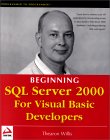 |
Beginning SQL Server 2000 for Visual Basic Developers
Authored by Thearon Willis |
|
Related items
Beginning SQL Server 2000 for Visual Basic Developers is targeted at intermediate to experienced VB developers craving to learn more about how to utilize SQL Server 2000. This book is the best introduction I have read on this topic in a long time. Familiarity with the concept of databases is recommended before you start, but standard "get this book" cliches apply nonetheless.
The first few chapters are primers, where the basic knowledge about SQL Server 2000's features and installation, and relational database design. The book is based on the progression of a project, and this project is outlined as well. If you feel comfortable with these topics, you may choose to glance at them quickly and then skip them, but for novice database users
the information is important. The most important tool, SQL Server's Query Analyzer, is covered in its own chapter.
Database essentials are covered thorougly when you learn how to connect to the database and query, modify and delete your data. The learning project is extended as knowledge accumulates, and maintains a high professional standard all the way.
No database book seems to complete without mentioning XML, and this one is no exception. SQL Server 2000 offers native XML and web support, the basics of which are covered here. You should be familiar with XML to fully enjoy this section. Another SQL Server feature, although not as frequently used as XML, is the English Query module. Allowing for natural language queries entered by the user, English Query can add a certain elegance to your applications.
For most VB developers, database access means ADO. The ADO object model is covered in one of the appendices, but is also the corner stone of the entire learning project. Reading this book should get you quite familiar with ADO.
The author presents the information in a clear and concise manner, and takes great care in being exhaustive in his explanations. I never felt that any part of a process were left unexplained or implied; when you don't have to skip back and forth to get the meaning of a paragraph, reading becomes all the more enjoyable.
In the introduction, the book is presented as a book for experienced VB developers with or without database experience. The basics of relational database design are covered in one of the first chapters, but this will probably not be enough for inexperienced database developers. The design phase of a database project is as important as the implementation, but the author focuses more on the latter throughout the book. A good foundation in relational database theory may prove necessary before the knowledge gained from this book can be correctly applied.
Conclusion: a good book if you want to get to know SQL Server 2000, but get some background on databases before you start.
Last update: 2025-12-22
Copyright 1995-2025 VBI

